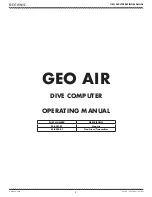
Gill Instruments Ltd
APPENDIX B
Principle of Operation
The basic time-of-flight operating principle is physically fundamental and provides vector
measurement of air velocity dependent mainly on the dimensions and geometry of the transducer
array. A pair of transducers act alternately as transmitters and receivers, sending pulses of high
frequency ultrasound between themselves. The times of flight in each direction, say t1 and t2, are
measured. If c is the speed of sound, L the distance between the transducers and there is an air flow
v along the line of the transducers, the following relationships are readily derived:-
t1 = L/(c+v) ; t2 = L/(c-v)
By inverting and subtracting, v is solved explicitly:-
v = 0.5L(1/t1-1/t2)
This wind vector derivation is not affected by c or any other parameters such as temperature or
contaminant content.
Conversely, c is obtained by inverting and adding:-
c = 0.5L(1/t1+1/t2)
v represents the vector component of air flow resolved along the line of the pair of transducers. By
arranging three pairs of transducers in different orientations, the direction and magnitude of the
incident air flow may be unambiguously derived. The transducer pairs do not have to conform to
cartesian axes. For optimum undisturbed airflow a non orthogonal arrangement is employed.
The main functions of the electronics are operation of the ultrasonics, processing of raw
measurement data, and high level data analysis and data transmission.
The velocities along each transducer axis are calculated as above.
If the anemometer is operating in a UVW mode a transformation is then carried out to calculate the
velocities in the U, V, W format. This transformation is given below.
If operating in a calibrated mode a correction operation is then applied to calibrate out the affects of
the transducers and head framework. The UVW processed data are then output on the serial output.
Vector Transformation
a1 = axis 1 velocity
a2 = axis 2 velocity
a3 = axis 3 velocity
Standard vector mathematics leads to the following equations:-
U velocity = (2a1 - a2 - a3)/1.9779
V velocity = (a3 - a2 )/1.1420
W velocity = (a1 + a2 + a3)/2.2555
HS-50 Research Anemometer
Page 51
Issue 02
Doc. No. 1199-PS-0032
November 2004
Summary of Contents for HS-50
Page 2: ......
















































